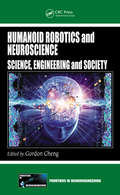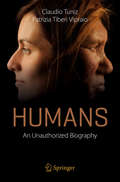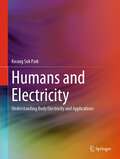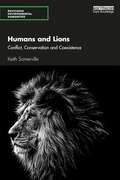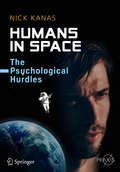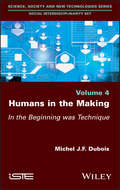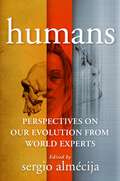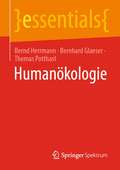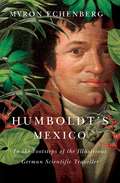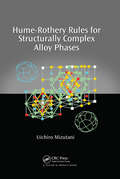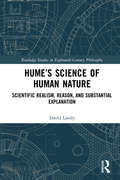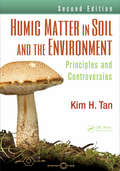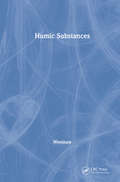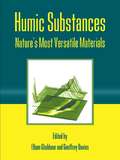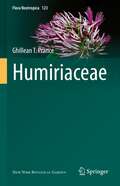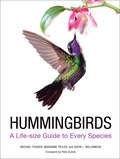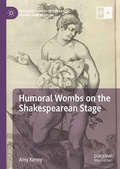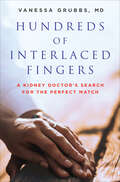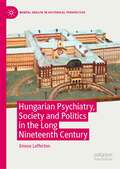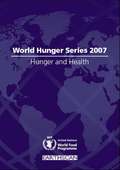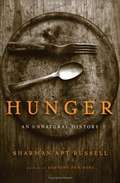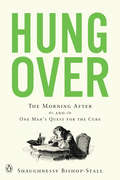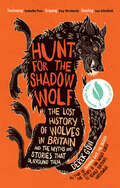- Table View
- List View
Humanoid Robotics and Neuroscience: Science, Engineering and Society
by Gordon ChengHumanoid robots are highly sophisticated machines equipped with human-like sensory and motor capabilities. Today we are on the verge of a new era of rapid transformations in both science and engineering-one that brings together technological advancements in a way that will accelerate both neuroscience and robotics. Humanoid Robotics and Neuroscienc
Humans
by Claudio Tuniz Patrizia Tiberi VipraioBased on the latest scientific discoveries, this "unauthorized biography" of the Humans recounts the story of our distant ancestors during the past 6 million years, since the line of our extended family separated from that leading to modern chimpanzees. The book explains how different species evolved, both anatomically and cognitively, and describes the impacts of climatic and environmental change on this process. It also explores the nature of relationships within and between species, describes their everyday lives, and discusses how isolated individuals became members of larger social groups. The concluding chapters highlight the paramount importance of the emergence of symbolic thought and discuss its contribution to the formation of institutions, societies, and economies. The multifaceted picture that emerges will help the reader to make sense not only of "what we were", but also of "what we are", here and now. The book is both entertaining and rigorous in integrating results from a wide selection of disciplines. It will be particularly suitable for people with a curious and open mind, keen to overcome long-standing prejudices on man's place in nature.
Humans and Electricity: Understanding Body Electricity and Applications
by Kwang Suk ParkHumans are electric beings. We are managed, monitored, and stimulated electrically. This textbook provides students and practitioners with a solid foundation and understanding of human electricity and the work currently being done to further develop electrical signals for medical purposes and related goals. The book introduces the fundamentals of how biological systems generate electrical signals, covering a wide range of biomedical engineering topics including bioelectricity, biomedical signals, neural engineering, and brain-computer interface. The book is presented in three sections: Part I explains how electrical signals and impulses manage the human body; Part II examines the kinds of electrical signals from the human body and how they are monitored, controlled, and used; Part III looks at clinical use of electrical stimulation toward the human body and how they are being developed for interventions in medicine. The book is also a valuable professional reference for practicing engineers and scientists. Explains humans as electric beings who are managed, monitored, and stimulated electrically;Deals with the electricity of major human organs;Covers a wide range of biomedical engineering topics
Humans and Lions: Conflict, Conservation and Coexistence (Routledge Environmental Humanities)
by Keith SomervilleThis book places lion conservation and the relationship between people and lions both in historical context and in the context of the contemporary politics of conservation in Africa. The killing of Cecil the Lion in July 2015 brought such issues to the public’s attention. Were lions threatened in the wild and what was the best form of conservation? How best can lions be saved from extinction in the wild in Africa amid rural poverty, precarious livelihoods for local communities and an expanding human population? This book traces man’s relationship with lions through history, from hominids, to the Romans, through colonial occupation and independence, to the present day. It concludes with an examination of the current crisis of conservation and the conflict between Western animal welfare concepts and sustainable development, thrown into sharp focus by the killing of Cecil the lion. Through this historical account, Keith Somerville provides a coherent, evidence-based assessment of current human-lion relations, providing context to the present situation. This book will be of interest to students and scholars of environmental and African history, wildlife conservation, environmental management and political ecology, as well as the general reader.
Humans and Their Place in the Universe (Inspire Science, Grade 8 Integrated #Unit 4)
by Douglas Fisher Ralph M. Feather Alton L. BiggsNIMAC-sourced textbook
Humans in Space
by Nick KanasUsing anecdotal reports from astronauts and cosmonauts, and the results from studies conducted in space analog environments on Earth and in the actual space environment, this book broadly reviews the various psychosocial issues that affect space travelers. Unlike other books that are more technical in format, this text is targeted for the general public. With the advent of space tourism and the increasing involvement of private enterprise in space, there is now a need to explore the impact of space missions on the human psyche and on the interpersonal relationships of the crewmembers. Separate chapters of the book deal with psychosocial stressors in space and in space analog environments; psychological, psychiatric, interpersonal, and cultural issues pertaining to space missions; positive growth-enhancing aspects of space travel; the crew-ground interaction; space tourism; countermeasures for dealing with space; and unique aspects of a trip to Mars, the outer solar system, and interstellar travel.
Humans in the Making: In the Beginning was Technique
by Michel J. DuboisThe human specificity can be described by verticality/bipedalism, technique use, articulated language, high cognitive capacities, complex society at three levels: body, mind, social. In this book, is proposed an evolutionary process that make better understand how such humanity could have emerged in the long time (more than 6 million years). The process is based on a very early necessity to use technic for surviving correlated with neoteny which impulsed a darwinian evolutionary process, with four distinguished punctuation described as neotenizations.
Humans: Perspectives on Our Evolution from World Experts
by Sergio AlmécijaHow did humanity evolve? And what does our evolutionary history tell us about what it means to be human? These questions are fundamental to our identity as individuals and as a species and to our relationship with the world. But there are almost as many answers to them as there are scientists who study these topics.This book brings together more than one hundred top experts, who share their insights on the study of human evolution and what it means for understanding our past, present, and future. Sergio Almécija asks leading figures across paleontology, primatology, archaeology, genetics, and many other disciplines about their lives, their work, and the philosophical significance of human evolution. They reflect on questions that are both fun and profound: What set you down your career path? Are humans special? Where and when would you travel in a time machine? Does human evolution offer lessons for society? Is evolution compatible with spirituality and religion?Humans features a remarkably accomplished cast of contributors, including Kay Behrensmeyer, Frans de Waal, Nina Jablonski, Richard Leakey, Robert Sapolsky, and Richard Wrangham. Together, they provide a refreshing, personable, engaging, cross-disciplinary, and thought-provoking exploration of different—even diametrically opposed—ideas about our nature and evolution, what makes humans unique, and what our future might hold. This book also offers practical suggestions for readers seeking to embark on a scientific career.
Humanökologie (essentials)
by Bernd Herrmann Thomas Potthast Bernhard Glaeseressentials liefern aktuelles Wissen in konzentrierter Form. Die Essenz dessen, worauf es als „State-of-the-Art“ in der gegenwärtigen Fachdiskussion oder in der Praxis ankommt. essentials informieren schnell, unkompliziert und verständlichals Einführung in ein aktuelles Thema aus Ihrem Fachgebietals Einstieg in ein für Sie noch unbekanntes Themenfeldals Einblick, um zum Thema mitreden zu könnenDie Bücher in elektronischer und gedruckter Form bringen das Expertenwissen von Springer-Fachautoren kompakt zur Darstellung. Sie sind besonders für die Nutzung als eBook auf Tablet-PCs, eBook-Readern und Smartphones geeignet. essentials: Wissensbausteine aus den Wirtschafts-, Sozial- und Geisteswissenschaften, aus Technik und Naturwissenschaften sowie aus Medizin, Psychologie und Gesundheitsberufen. Von renommierten Autoren aller Springer-Verlagsmarken.
Humboldt's Mexico: In the Footsteps of the Illustrious German Scientific Traveller
by Myron EchenbergThe incalculable influence of Alexander von Humboldt (1769–1859) on biology, botany, geology, and meteorology deservedly earned him the reputation as the world’s most illustrious scientist before Charles Darwin. Humboldt’s breath-taking explorations of Mexico and South America from 1799 to 1804 are akin to Europe’s second “discovery” of the New World – this time, a scientific one. His Political Essay on the Kingdom of New Spain is a foundational document about Mexico and its cultures and is still widely consulted by anthropologists, geographers, and historians. In Humboldt’s Mexico, Myron Echenberg presents a straightforward guide with historical and cultural context to Humboldt’s travels in Mexico. Humboldt packed a lifetime of scientific studies into one daunting year, and soon after published a four-volume account of his findings. His adventures range widely from inspections of colonial silver mines and hikes to the summits of volcanoes to meticulous examination of secret Spanish colonial archives in Mexico City and scientific discussions of archaeological sites of pre-Hispanic Indigenous cultures. Echenberg traces Humboldt’s journey, as described in his publications, his diary, and other writings, across the heartland of Mexico, while also pursuing Humboldt’s life, his science, his experiences, his influence on scholars of his time and after, and the various efforts by others to honour and at times to denigrate his legacy. Part history, part travelogue, and always highly readable and informative, Humboldt’s Mexico is an engaging account of a gifted scientist and visionary that ranges across topics as diverse and broad as natural history was in his era.
Hume-Rothery Rules for Structurally Complex Alloy Phases
by Uichiro MizutaniWith a history that reaches back some 90 years, the Hume-Rothery rules were developed to provide guiding principles in the search for new alloys. Ultimately, the rules bridged metallurgy, crystallography, and physics in a way that led to the emergence of a physics of the solid state in 1930s, although the physical implications of the rules were nev
Humean Bodies and their Consequences (Jerusalem Studies in Philosophy and History of Science)
by Ruth WeintraubThis book defends the very contentious Idealist interpretation of Hume on external objects, and draws from it far-reaching metaphysical and epistemological consequences for Hume’s philosophy. Its interest is both interpretive and analytic. The content Hume ascribes to the belief in “bodies” is susceptible to more than one reading, and has not been systematically considered. Upholding the Idealistic interpretation is interesting in its own right, but also yields several important conclusions about the spatiality of objects, causation, Hume’s “science of man” and his epistemology. For instance, it argues that the Idealist reading means that there are no cross-temporal spatial relationships, and that the (more prevalent) Materialist reading takes Hume further away from methodological empiricism than does the Idealist counterpart, and may render his practice less in conformity with his official methodology. The monograph is therefore of great interest to not only academics but also scholars, graduate students and researchers.
Hume’s Science of Human Nature: Scientific Realism, Reason, and Substantial Explanation (Routledge Studies in Eighteenth-Century Philosophy)
by David LandyHume’s Science of Human Nature is an investigation of the philosophical commitments underlying Hume's methodology in pursuing what he calls ‘the science of human nature’. It argues that Hume understands scientific explanation as aiming at explaining the inductively-established universal regularities discovered in experience via an appeal to the nature of the substance underlying manifest phenomena. For years, scholars have taken Hume to employ a deliberately shallow and demonstrably untenable notion of scientific explanation. By contrast, Hume’s Science of Human Nature sets out to update our understanding of Hume’s methodology by using a more sophisticated picture of science as a model.
Humic Matter in Soil and the Environment: Principles and Controversies, Second Edition (Books in Soils, Plants, and the Environment)
by Kim H. TanThe field of humic matter research has undergone drastic changes in concepts and principles since the first edition of Humic Matter in Soil and the Environment: Principles and Controversies was published more than a decade ago. Still the only book of its kind specifically addressing humic acid principles and controversies, the Second Edition presen
Humic Substances
by Robert L. Wershaw Michael A. MikitaThis book is an introduction and guide to the use of nuclear magnetic resonance (NMR) spectroscopy for the study of humic materials and coals. It provides a general discussion of the application of liquid-state and solid-state NMR techniques.
Humic Substances: Nature's Most Versatile Materials
by G. Davies E. GhabbourHumic substances are ubiquitous in the environment. These remarkable brown biomaterials are found in animals, plants, coals, sediments, soils and water. They are crucial components of the carbon cycle and other life processes. Humic Substances: Nature's Most Versatile Materials contains a compilation of papers presented at the 2002 Humic Substances Seminar and will keep humic substances scientists up to date with the latest research.
Humiriaceae (Flora Neotropica #123)
by Ghillean T. PranceThis book provides a comprehensive monograph of the family Humiraceae. It includes information on economic botany, conservation, phylogenetic relationships, taxonomic history, ecology, cytology, anatomy, and phytochemistry, among other topics. This volume is illustrated with line drawings, black and white photographs, and distribution maps. It was written by the world-leading authority on this plant group and contains a total of eight genera, 65 species, and 15 infraspecific taxa, with two new species described. This work is volume 123 in the Flora Neotropica book series (Lawrence M. Kelly, Editor-in-Chief). Flora Neotropica volumes provide taxonomic treatments of plant groups or families growing in the Americas between the Tropic of Cancer and the Tropic of Capricorn.
Hummingbirds: A Life-size Guide to Every Species
by Marianne Taylor Sheri L. Williamson Michael Fogden“Packed with information . . . this book showcases species such as the Green-crowned Brilliant, the Fiery Topaz and . . . Cuban Bee Hummingbird.” —Daily MailHummingbirds have always held popular appeal, with their visual brilliance, extraordinary flight dexterity, jewel-like color, and remarkably small size.This is the first book to profile all 338 known species, from the Saw-billed Hermit to the Scintillant Hummingbird.Every bird is shown life-size in glorious full-color photographs.Every species profile includes a flight map and key statistics, as well as information about behavior, plumage, and habitat.This authoritative guide has been annotated by the world’s leading experts on hummingbirds and features a foreword by renowned birding author Pete Dunne.
Humoral Wombs on the Shakespearean Stage (Palgrave Studies in Literature, Science and Medicine)
by Amy KennyThis book explores how the humoral womb was evoked, enacted, and embodied on the Shakespearean stage by considering the intersection of performance studies and humoral theory. Galenic naturalism applied the four humors—yellow bile, black bile, phlegm, and blood—to delineate women as porous, polluting, and susceptible to their environment. This book draws on early modern medical texts to provocatively demonstrate how Shakespeare’s canon offers a unique agency to female characters via humoral discourse of the womb. Chapters discuss early modern medicine’s attempt to theorize and interpret the womb, specifically its role in disease, excretion, and conception, alongside passages of Shakespeare’s plays to offer a fresh reading of (geo)humoral subjectivity. The book shows how Shakespeare subversively challenges contemporary notions of female fluidity by accentuating the significance of the womb as a source of self-defiance and autonomy for female characters across his canon.
Hundreds of Interlaced Fingers: A Kidney Doctor's Search for the Perfect Match
by Vanessa GrubbsA doctor shares her unforgettable love story & informative journey into the world of medicine in this “thoughtful and endearing” memoir (Washington Post).When Vanessa met Robert, she had no idea that their relationship would thoroughly transform her life. Robert was suffering from end-stage kidney disease, which required him to endure years of debilitating dialysis in order to stay alive, at least until his failed organ could be replaced by a kidney transplant. Although Vanessa was a primary care doctor, she developed a deeper understanding of the difficulties Robert faced, including dialysis and finding a donor. So, even though they were still in the early stages of their relationship, she volunteered one of her own kidneys for testing and discovered that she was a match. This life-affirming donation forged a bond that would become a pillar of Vanessa and Robert’s marriage—and the beginning of a new career.Motivated by Robert’s experience and her newfound knowledge, Vanessa became a nephrologist—a kidney doctor—and discovered far more about the realities of the specialty. Shaped by Vanessa’s remarkable expertise as a doctor, a woman of color, a mother, and a kidney donor, Hundreds of Interlaced Fingers is a love story as well as an informative guide to kidney disease.Praise for Hundreds of Interlaced Fingers“A story told beautifully, courageously, and honestly. You’ll never forget Vanessa and Robert, and you’ll never view medicine quite the same way again.” —Robert Winchester, MD, author of the New York Times–bestseller The Digital Doctor“Intense, ambitious, and fascinating.” —Victoria Sweet, MD, award–winning author of God’s Hotel
Hungarian Psychiatry, Society and Politics in the Long Nineteenth Century (Mental Health in Historical Perspective)
by Emese LaffertonThis book provides the first comprehensive study of the history of Hungarian psychiatry between 1850 and 1920, placed in both an Austro-Hungarian and wider European comparative framework. Taking an interdisciplinary approach, the book captures the institutional worlds of the different types of psychiatric institutions intertwined with the intellectual history of mental illness and the micro-historical study of everyday institutional practice. It uncovers the ways in which psychiatrists gradually organised themselves and their profession, defined their field and role, claimed expertise within the medical sciences, lobbied for legal reform and the establishment of psychiatric institutions, fought for university positions, the establishment of departments and specialised psychiatric teaching. Beyond this story of increasing professionalization, this study also explores how psychiatry became invested in social critique. It shows how psychiatry gradually moved beyond its closely defined disciplinary borders and became a public arena, with psychiatrists broadening their focus from individual patients to society at large, whether through mass publications or participation in popular social movements. Finally, the book examines how psychiatry began to influence the concept of mental health during the first decades of the twentieth century, against the rich social and cultural context of fin-de-siècle Budapest and the Austro-Hungarian Dual Monarchy.
Hunger and Health: World Hunger Series 2007
by United Nations World Food ProgrammeHunger and Health explores the multiple relationships between hunger and poor health, and how they affect the growth of individuals, physiologically and psychologically, constraining the development of nations both socially and economically. Examining the profound effect that hunger has on health, including disease prevention and treatment, it gives special attention to access to quality food and healthcare, in particular for the marginalized and poor. It also identifies critical junctures in the human life cycle when the benefits of reducing hunger and improving poor health have a profound impact. It demonstrates how aligning of hunger and health interventions can offer proven solutions that reach those most in need, and contains compelling evidence which confirms that hunger and poor health are solvable problems today. It encourages those involved in policy, programming and advocacy to take action to address some of the most urgent hunger and health problems. Essential reading for anyone concerned about eliminating hunger. Published with the UN World Food Programme.
Hunger: An Unnatural History
by Sharman Apt RussellA subject as big as history and as everyday as skipping lunch -- how does hunger work? -- is explored in this thought-provoking, kaleidoscopic blend of science, anthropology, and personal reflection.
Hungover: The Morning After and One Man's Quest for the Cure
by Shaughnessy Bishop-Stall"An engrossing, hilarious, and sometimes painful tour through the history and science of the morning after." —Bianca Bosker, author of Cork Dork One intrepid reporter's quest to learn everything there is to know about hangovers, trying all of the cures he can find and explaining how (and if) they work, all so rest of us don't have to.We've all been there. One minute you're fast asleep, and in the next you're tumbling from dreams of deserts and demons, into semi-consciousness, mouth full of sand, head throbbing. You're hungover. Courageous journalist Shaughnessy Bishop-Stall has gone to the front lines of humanity's age-old fight against hangovers to settle once and for all the best way to get rid of the aftereffects of a night of indulgence (short of not drinking in the first place).Hangovers have plagued human beings for about as long as civilization has existed (and arguably longer), so there has been plenty of time for cures to be concocted. But even in 2018, little is actually known about hangovers, and less still about how to cure them. Cutting through the rumor and the myth, Hungover explores everything from polar bear swims, to saline IV drips, to the age-old hair of the dog, to let us all know which ones actually work. And along the way, Bishop-Stall regales readers with stories from humanity's long and fraught relationship with booze, and shares the advice of everyone from Kingsley Amis to a man in a pub.
Hunt for the Shadow Wolf [US Edition]: The lost history of wolves in Britain and the myths and stories that surround them
by Derek Gow"Terrific, life-lit moments come howling out of Hunt for the Shadow Wolf."—The Telegraph "[Derek Gow is] a wry, profane truth teller who is equal parts yeoman farmer, historical ecologist, and pirate."—Ben Goldfarb, author of Eager and Crossings "Beautifully crafted, fascinating and unbearably poignant, I totally loved this book."—Isabella Tree, author of Wilding Renowned rewilder Derek Gow has a dream: that one day we will see the return of the wolf to Britain as it has already returned elsewhere. As Derek worked to reintroduce the beaver, he began to hear stories of the wolf, both real and mythical, and his fascination with this creature grew. With increasing curiosity, Derek started to piece together fragments of information, stories and artefacts to reveal a shadowy creature that first walked proud through these lands and then was hunted to extinction as coexistence turned to fear, hatred – and domination. What Derek came to realize was that the underlying motives behind our hatred were actually far more prosaic and, like most persecutions, to do with power and profit. We turned the wolf into a savage beast and saw its extirpation as a civilizing mission. But the wolf survived far longer than many thought and Derek tells of his sightings of the wolf through folklore and mythology, the records of grand estates and parish churches as well as wolf heads, both real and recreated. With bitingly funny but also tender stories, Hunt for the Shadow Wolf is Derek’s quest to uncover the true nature of this creature because, as we seek to heal our landscape, we must reconcile our relationship with it. Before we can even begin to bring the wolf back, we need to understand it. "I have loved this chase dearly and though what unfolds might be an ending of sorts, I have no intention to let this hunt cease."―Derek Gow, from Hunt for the Shadow Wolf "Gow reinvents what it means to be a guardian of the countryside."—The Guardian
